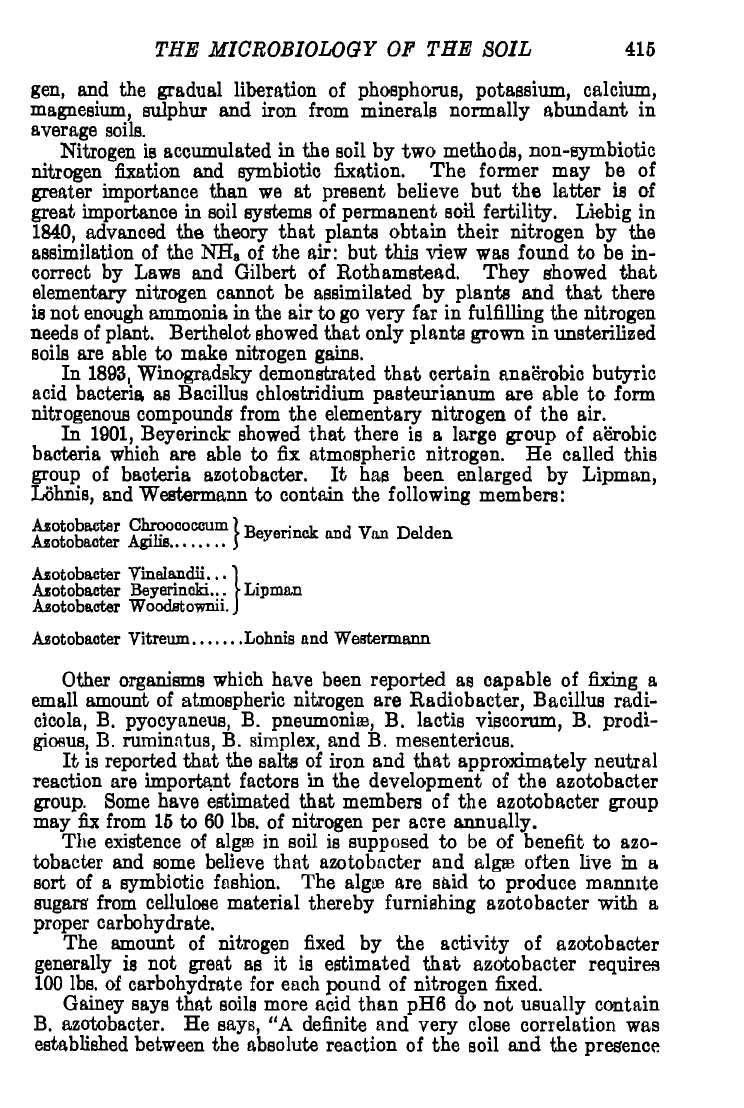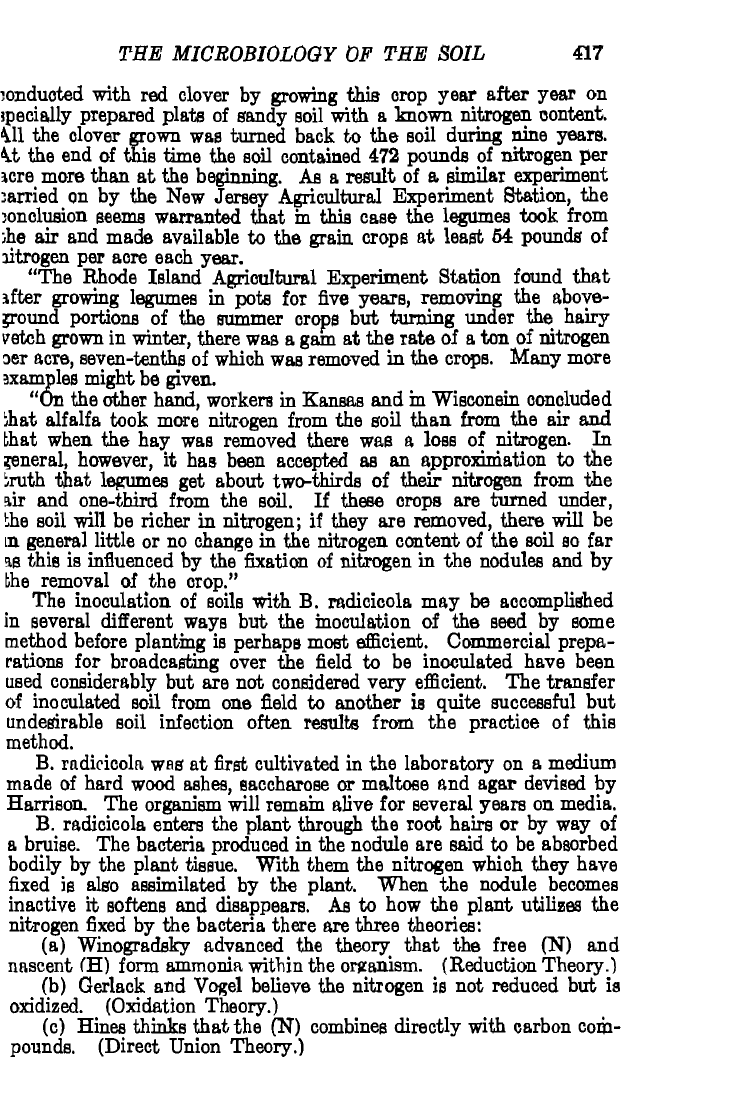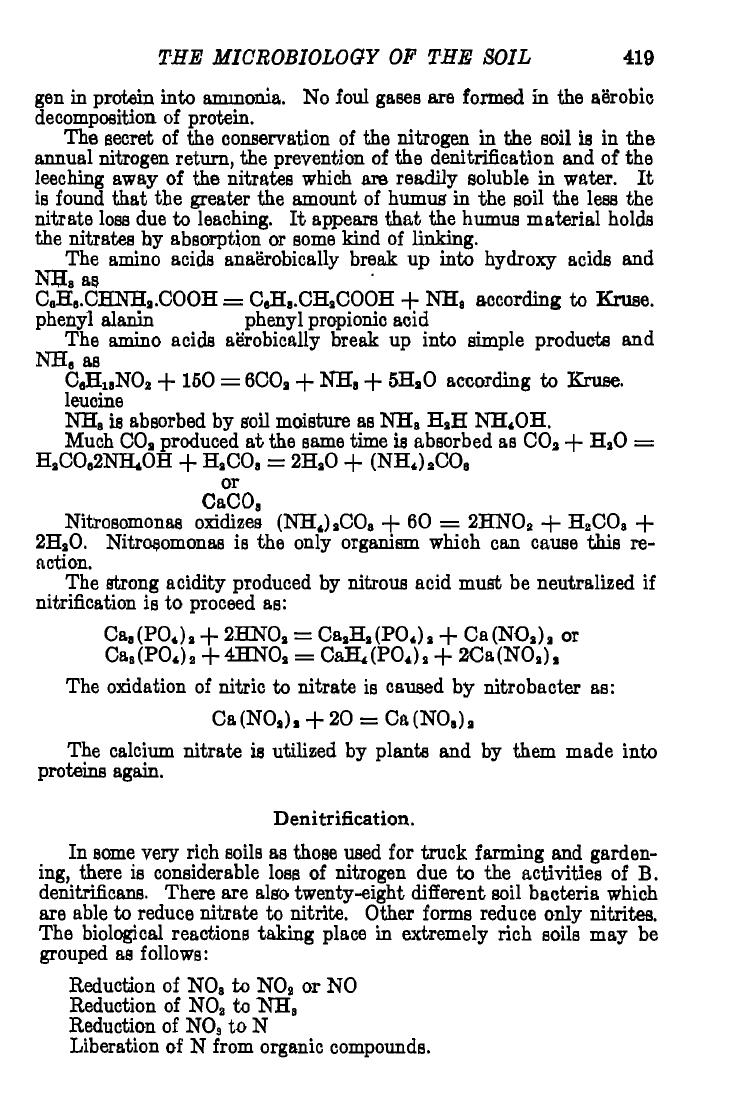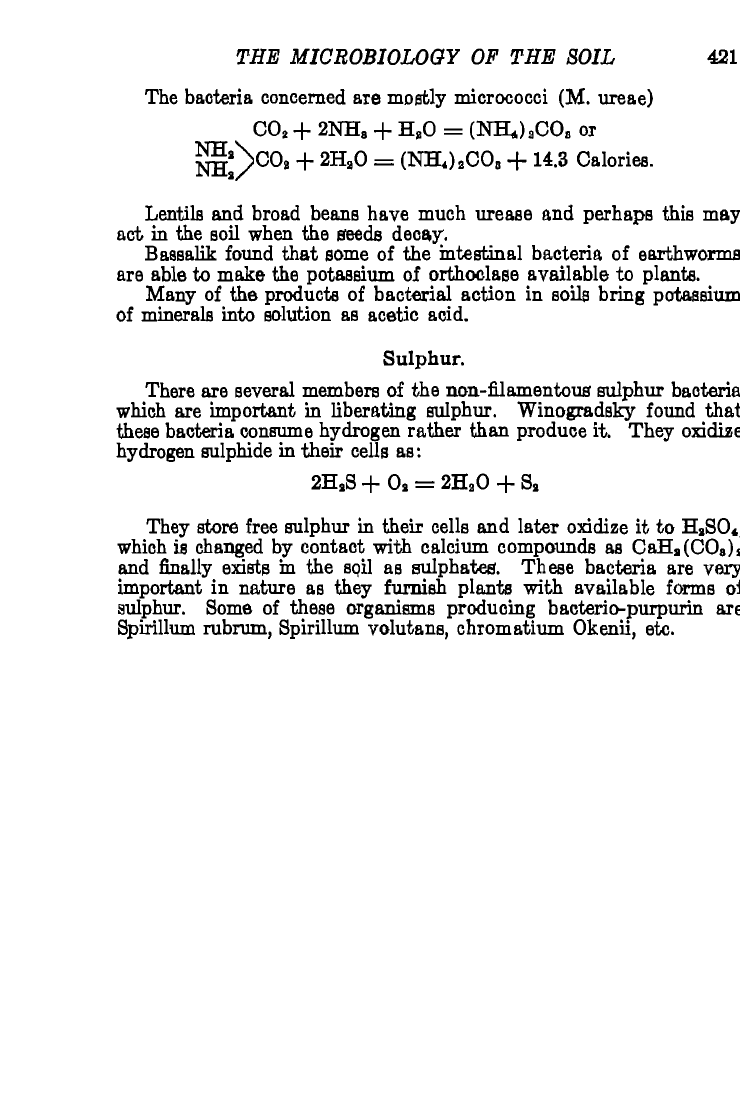Allen Paul W. Industrial Fermentations
Подождите немного. Документ загружается.


THE MICROBIOLOGY OF THE SOIL 415
gen, and the gradual liberation of phosphorus, potassium, calcium,
magnesium, sulphur and iron from minerals normally abundant in
average soils.
Nitrogen is accumulated in the soil by two methods, non-symbiotic
nitrogen fixation and symbiotic fixation. The former may be of
greater importance than we at present believe but the latter is of
great importance in soil systems of permanent soil fertility. Liebig in
1840,
advanoed the theory that plants obtain their nitrogen by the
assimilation of the NH
a
of the air: but this view was found to be in-
correct by Laws and Gilbert of Rothamstead. They showed that
elementary nitrogen cannot be assimilated by plants and that there
is not enough ammonia in the air to go very far in fulfilling the nitrogen
needs of plant. Berthelot showed that only plants grown in unsterilized
soils are able to make nitrogen gains.
In 1893, Winogradsky demonstrated that certain anaerobic butyric
acid bacteria as Bacillus chlostridium pasteurianum are able to form
nitrogenous compounds' from the elementary nitrogen of the air.
In 1901, Beyerinckr showed that there is a large group of aerobic
bacteria which are able to fix atmospheric nitrogen. He called this
group of bacteria azotobacter. It has been enlarged by Lipman,
Lohnis, and Westennann to contain the following members:
Azotobacter Vinelandii... ]
Azotobacter Beyerinoki...
>
Lipman
Azotobacter Woodstownii. J
Azotobaoter Vitreum Lohnis and Wefltennann
Other organisms which have been reported as oapable of fixing a
small amount of atmospheric nitrogen are Radiobacter, Bacillus radi-
cicola, B. pyocyaneus, B. pneumonia, B. lactis viscorum, B. prodi-
giosus, B. ruminatus, B. simplex, and B. mesentericus.
It is reported that the salts of iron and that approximately neutral
reaction are important factors in the development of the azotobacter
group. Some have estimated that members of the azotobacter group
may fix from 15 to 60 lbs. of nitrogen per acre annually.
The existence of alga in soil is supposed to be of benefit to azo-
tobacter and some believe that azotobncter and algse often live in a
sort of a symbiotic fashion. The algae are said to produce mannite
sugars' from cellulose material thereby furnishing azotobacter with a
proper carbohydrate.
The amount of nitrogen fixed by the activity of azotobacter
generally is not great as it is estimated that azotobacter requires
100 lbs. of carbohydrate for each pound of nitrogen fixed.
Gainey says that soils more acid than pH6 do not usually contain
B.
azotobacter. He says, "A definite and very close correlation was
established between the absolute reaction of the soil and the presence

416 INDUSTRIAL FERMENTATIONS
or absence of azotobacter in the soil." He further says that since a
very limiting H ion concentration was found for pure cultures of azo-
tobaoter in laboratory media, it is believed that the very close correla-
tion existing between the reaction and the presence of azotobacter
indicated that the absolute reaction is of paramount importance if
not the actual limiting factor in controlling the presence of this group
of organisms' in soils.
Symbiotic Nitrogen Fixation.
In ancient Roman times acoording to Columella, fanners con-
sidered that the growing of beans, alfalfa, lupines and vetches improved
the soil and acted as manure. However more definite knowledge was
not obtained until 1888 when Hellriegel and Wilfarth established
the fact that certain plants and bacteria work together in the fixing
of atmospheric nitrogen in the soil. Legumes were found to fix nitro-
gen by a symbiotic activity between the plant root and a bacillus
which was called B. radicicola, the symbiosis resulting in tubercle
formation on the plant roots. These tubercles had first been observed
by Malpighi in 1687, who erroneously thought they were pathological
processes. Marshall Ward studied these root tubercles and discovered
that they were due to outside infection of the root, but it was left for
Hellriegel and Wilfarth to interpret their true importance as atmos-
pheric nitrogen fixers.
C. V. Piper in explaining how muoh nitrogen legumes may add to
the soil by the practice of green manuring says:
"Attempts have been made to determine the quantities of nitrogen
fixe4 by the action of the nodule bacteria, but no method has yet
been found that will give more than an approximately correct answer.
Analyses have been made of the quantities of nitrogen in various
leguminous crops, both tops and roots, but the total nitrogen thus
obtained includes some that was
1
taken directly from the soil. De-
terminations have been made of the total nitrogen in soils before and
after growing a leguminous crop, but the result represents merely the
net difference between gain and loss resulting from the interplay of a
number of factors, and even the net gain cannot be safely credited to
the legume alone. Lastly, oertain legumes have been grown with and
without inoculation and the difference in the quantities of nitrogen in
the crops determined.
"The Michigan Agricultural Experiment Station grew soy beans
inoculating the soil on one field and leaving another uninoculated.
Samples taken and analyzed showed that about two-thirds of the
total nitrogen was taken from the soil and one-third from the air. The
Illinois Agricultural Experiment Station grew alfalfa, both in pots
and in field plats, some inoculated, others not. On the inoculated
plate the alfalfa in the crops for a season contained nearly 160 pounds
more nitrogen per acre than the crop from the uninoculated plats.
"At the Central Experimental Farm at Ottawa, experiments were

THE MICROBIOLOGY OF THE SOIL 417
;onduoted with red clover by growing this crop year after year on
specially prepared plats of sandy soil with a known nitrogen content.
£ll the clover grown was turned back to the soil during nine years,
^t the end of this time the soil contained 472 pounds of nitrogen per
icre more than at the beginning. As a result of a similar experiment
carried on by the New Jersey Agricultural Experiment Station, the
3onclusion seems warranted that in this case the legumes took from
:he air and made available to the grain crops at least 64 pounds of
litrogen per acre each year.
"The Rhode Island Agricultural Experiment Station found that
after growing legumes in pots for five years, removing the above-
ground portions of the summer cropB but turning under the hairy
vetch grown in winter, there was a gain at the rate of a ton of nitrogen
oer acre, seven-tenths of which was removed in the crops. Many more
axamples might be given.
"On the other hand, workers in Kansas and in Wisconsin ooncluded
that alfalfa took more nitrogen from the soil than from the air and
that when the hay was removed there was a loss of nitrogen. In
general, however, it has been accepted as an approximation to the
truth that legumes get about two-thirds of their nitrogen from the
air and one-third from the soil. If these orops are turned under,
the soil will be richer in nitrogen; if they are removed, there will be
in general little or no change in the nitrogen content of the soil so far
as this is influenced by the fixation of nitrogen in the nodules and by
the removal of ^the crop."
The inoculation of soils with B. radicicola may be accomplished
in several different ways but the inooulation of the seed by some
method before planting is perhaps most efficient. Commercial prepa-
rations for broadcasting over the field to be inoculated have been
used considerably but are not considered very efficient. The transfer
of inoculated soil from one field to another is quite successful but
undesirable soil infection often results from the practice of this
method.
B.
radicicola was
1
at first cultivated in the laboratory on a medium
made of hard wood ashes, saccharose or maltose and agar devised by
Harrison. The organism will remain alive for several years on media.
B.
radicicola enters the plant through the root hairs or by way of
a bruise. The bacteria produced in the nodule are said to be absorbed
bodily by the plant tissue. With them the nitrogen whioh they have
fixed is also assimilated by the plant. When the nodule becomes
inactive it softens and disappears. As to how the plant utilizes the
nitrogen fixed by the bacteria there are three theories:
(a) Winogradsky advanced the theory that the free (N) and
nascent (H) form ammonia within the organism. (Reduction Theory.)
(b) Gerlack and Vogel believe the nitrogen is not reduced but is
oxidized. (Oxidation Theory.)
(c) Hines thinks that the (N) combines directly with carbon com-
pounds. (Direct Union Theory.)

418
INDUSTRIAL FERMENTATIONS
It was.reported at N. J. Agr. Exp, Station that 200 lbs. of nitrogen
per acre was., fixed by B, radicicola in one year.
The conservation of the fertility of the soil is principally the con-
servation of nitrogen. Whatever the form in which nitrogen exists in
soil it is moving in the nitrogen cycle. Organic nitrogen is mainly
in the form of protein or protein derivatives of animal or vegetable
products. Nitrogen in protein exists in five different forms as:
1 amino nitrogen
2 diaminp nitrogen
3 ammonia nitrogen
4 guanidin nitrogen
5 pigment forms
Whatever the form of the organic nitrogen product it is attacked
in normal soil by bacteria.
Some of the organisms which split protein to ammonia are B. sub-
tilis,
B. mesenterious, B. mycoides, B. fluorescens liquefaciens, B.
fluorescens putidus, Saroena lutea, B. arboreacens, B. proteus vulgatus,
B.
pyocyaneue, B. panthimiB. All the above organisms are strong
aerobee with the exception of B. proteus and B. fluorescens putidus.
In the breaking down of protein in soil the arnmonifiers carry the
simplicationof the protein molecule to a point where the main de-
rivatives are hydioxy aeids and ammonia. Other products are formed
in a lesser degree.
B.
mycoides according to Kruse oonverte 46% of the nitrogen in
protein into ammonia while B. pyocyaneus converts 70% of the nitro-
THD NITROGEN CTCLK PBOM PEOTEN TO PBOTEIN (A POSSIBLE CYCLE). KIIUBE.
Trypsiiiand similar enzymes (alkaline proteinase)
| Pepsin and similar enaymes (acid proteinaae)
Complex Protein Molecule
Amino
acid
Proteoses
Ami-no
acid
Peptones
Amino
acid
Polypeptlds
Amino
acid
Peptida
Amino
acid
Amino
acids
Erepsin and similar enzymes
•HTDHOLTTIO CHAN0E8

THE MICROBIOLOGY OF THE SOIL 419
gen in protein into ammonia. No foul gases are formed in the aerobic
decomposition of protein.
The secret of the conservation of the nitrogen iii the soil is in the
annual nitrogen return, the prevention of the denitrification and of the
leeching away of the nitrates which are readily soluble in water. It
is found that the greater the amount of humus' in the soil the less the
nitrate loss due to leaching. It appears that the humus material holds
the nitrates by absorption or some kind of linking.
The amino acids anaerobically break up into hydroxy acids and
NH
a
as
C
a
H
fl
.CHNH
fl
.COOH = CeH
B
.CH
a
COOH + NH
8
according to Kruse.
phenyl alanin phenyl propionio acid
The amino acids aerobically break up into simple products and
NH
8
as
CHuNOa + 150 = 6CO
a
+ NH, + 5H
a
O according to Kruse.
leuoine
NH
8
is absorbed by soil moisture as NH
B
H
a
H NH*0H.
Much CO
a
produced at the same time is absorbed as C0
3
-j- H
a
O =
HjCO^NH^OH + H
a
C0
8
= 2H
a
0 + (NH
4
)
a
C0
8
or
CaC0
8
Nitrosomonaa oxidizes (NHJ
a
C0
8
+ 60 = 2HNO
2
+ H
a
C0
8
+
2H
?
0.
Nitrosomonas is the only organism which can cause this re-
action.
The strong acidity produced by nitrous acid must be neutralized if
nitrification is to proceed as:
Ca
8
(PO
4
)
a
+ 2HN0
a
= CaACPO*), + Ca(NO
a
)
a
or
Ca
8
(PO<)
a
+ 4HN0
a
= CaH*(P0
4
)a + 2Ca(N0
2
)
f
The oxidation of nitric to nitrate is caused by nitrobacter as:
Ca(NO
a
)
1
+ 2O = Ca(NO
8
)
a
The calcium nitrate is utilized by plants and by them made into
proteins again.
Denitrification.
In some very rich soils as those used for truck farming and garden-
ing, there is considerable loss of nitrogen due to the activities of B.
denitrificans. There are also twenty-eight different soil bacteria which
are able to reduce nitrate to nitrite. Other forms reduce only nitrites.
The biological reactions taking place in extremely rich soils may be
grouped as follows:
Reduction of N0
8
to N0
2
or NO
Reduction of NO
a
to TtfH
8
Reduction of N0
9
to N
Liberation of N from organic compounds.

420 INDUSTRIAL FERMENTATIONS
Carbohydrates as starch, sugars and other residues of crops may
furnish the carbon for these reductions.
Denitrification in ordinary soils is not extensive and causes very
little loss of nitrogen but in heavily manured and wnter logged soils
it may be an important faotor.
Phosphorus.
The slow but gradual liberation of phosphorus, potassium, sulphur
and other essential mineral elements of plant growth is quite satisfac-
tory in average soils. While no phosphorus fermenting organism has
ever been found still Stoklaaa found that P
a
O
D
in phosphate was made
soluble by bacteria as follows:
Unmodulated 3.8%
B.myoaides 23 %
B.
megatherium 21 %
B.coli 20 %
B.
meeentericus 15 %
B.butyrioua 15 %
B.proteus 14 %
B.fluorescens 9.2%
It was found that acetic acid and formic acid are better solvents
of phosphates than carbonic acid. Lipman thinks that sulphur makes
phosphorus in phosphates available.
Potassium.
Some of the sources of potassium in soils are
Orthoclase
Feldspar (muscovite)
Mica (biotite)
Peroxines
Labradorite
There is evidence that potassium is made available to plants by
the action of bacteria.
Soluble potassium may be made available to plants by the action
of biological end products upon .the zeolrtjic compounds of the soil.
Maclntire has shown, however, that the economic additions of calcic
and inorganic materials functioj/ to protect native soil potassium and
give a repressive rather than a liberative chemical effect.
^ According to Kruse, urea is an important constituent of manured
soilB.
Urea C0(NH
a
)
2
the chief nitrogenous constituent of urine and
the principal end point of tissue metamorphosis is attacked by the urea
organisms and converted into ammonia and CO
8
as:
C0(NH
2
)
3
+ H
2
O = CO
2
+ 2NH
8
(Hydrolysis (enzyme)
(urease)

THE MICROBIOLOGY OF THE SOIL 421
The baoteria concerned are mostly micrococci (M. ureae)
CO
2
+ 2NH
8
-f H
8
O = (NHJaCOs or
O
a
+ 2H
a
O = (NH
4
)
2
CO
8
+ 14.3 Calories.
Lentils and broad beans have much urease and perhaps this may
act in the soil when the Heeds decay.
Bassalik found that some of the intestinal bacteria of earthworms
are able to make the potassium of orthoclase available to plants.
Many of the products of bacterial action in soils bring potassium
of minerals into solution as acetic acid.
Sulphur.
There are several members of the non-filamentous
1
sulphur baoteria
which are important in liberating sulphur. Winogradsky found that
these bacteria consume hydrogen rather than produce it. They oxidize
hydrogen sulphide in their cells BB:
2H
2
S + O
8
= 2H
a
O -f- S
2
They store free sulphur in their cells and later oxidize it to HaSO*,
whioh is changed by contaot with calcium compounds as CaH
a
(CO
8
)a
and finally exists in the spil as sulphates'. These bacteria are very
important in nature as they furnish plants with available forms of
sulphur. Some of these organisms producing bacterio-purpurin are
Spirillum rubrum, Spirillum volutans, chromatium Okenii, etc.


INDEX
Acetaldehyde, 12
Acetic Acid, 104
Acetic Acid Fermentation, 296
Acetone, 106
Activated Sludge, 116
Alcohol from Cellulose, 17
Alcohol Manufacture, 17
Alcoholic Fermentation, 11
Alcoholic Yeasts, 11
Analysis of Apple Juice, 298
Anthrax, 41
Appert, 243
Bacillus Typhosufl, 71
Barms, 134
Bating, 44
Beet Sugar, 263
Blue-Stain, 83
Bone Black Filters, 183
Botulism, 256
Bread, 128
Bread Constituents, 151
Bread Improvers, 143
Bread-Making Losses, 146
Buffalo Skins, 40
Cane Sugar, 263
Carbolic Acid, 72
Cellobiose, 18
Cellulose, 19
Centrifugahzation, 263
Chemical Retting, 51
Chromogenic Breads, 150
Citric Acid, 105
Cocoa, 335
Coefficient of Disinfection, 71
Coffee, 335
Cold Storage, 210
Composition of Vinegar, 292
Concentration, 230
Confirmed Test, 341
Contact Filters, 120
Corn, 27
Corn Oil, 188
Corn Products, 168
Creosote, 88
Damaged Corn, 194
Decay in Eggs, 347
Denatured Alcohol, 15
Denitrification, 319
Depilation, 43
Dew Retting, 49
Dill Pickles, 232"
Disinfectants, 66
Disinfection of Hides, 44
Distillery, 29
Drinking Water, 337
Dry Heat, 67
Drying, 218
Dry Salt Pork, 276
Egg Preservatives, 354
Eggs,
347
Enaymea of Yeast, 14
Ethyl Alcohol, 13
Flax 53
Food Preservatives, 205
Formaldehyde, 72
Fuel Gasea, 26
Fusel Oil, 13
Gasoline, 66
Grape Sugar, 58
Green Molt, 30
Glycerin, 110
Glycerol, 12
Glucose, 181
Grit Chambers, 115
Hemp, 47
Imhoff TJink, 116
Incineration, 66
Indigo, 92
Indigo Fermentation, 91
Inoculation. 57
Industrial Alcohol, 12
Invertase, 14
Kippered Salmon, 289
Lactic Add, 104
Leather, 39
Legume Cultures, 84
Malt, 144
Malt Vinegar, 305
Maple Sugar, 357
Maple Syrup, 357
Marine Products, 278
423
